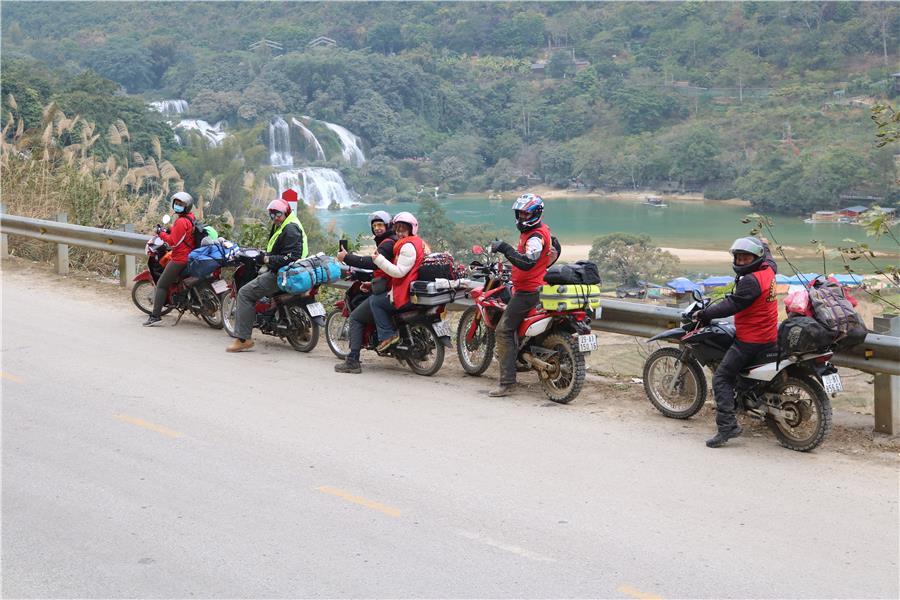Sa pa
Sapa to Ha Giang: Your Ultimate Travel Guide for an Unforgettable Journey
Traveling from Sapa to Ha Giang is an adventure that promises breathtaking landscapes, winding mountain roads, and an authentic glimpse into Northern Vietnam’s rural charm. Whether you’re a seasoned traveler or a first-time visitor, this journey offers an opportunity to experience the beauty and culture of Vietnam’s northern highlands. From planning your route to choosing the right transportation, Vietnam Dope Travel covers everything you need to make your trip from Sapa to Ha Giang truly memorable.
Something you should know about Ha Giang
Ha Giang, located at Vietnam’s northernmost tip and bordering China, sits at an elevation of around 2000 meters above sea level. This region is blessed with stunning natural landscapes, featuring majestic mountains, lush forests, winding rivers, and expansive fields.
Visitors to this Northeastern area can immerse themselves in both the breathtaking natural scenery and the rich cultural tapestry of 24 distinct ethnic groups residing here. The harmonious blend of nature, culture, and the warmth of the people contributes to Ha Giang’s undeniable charm. It’s often said that “Ha Giang leaves many with a deep, lingering affection,” and a single visit often sparks a desire to return multiple times.
Ha Giang is a destination for all seasons. While autumn is popular for the golden hue of ripe rice fields, the period from October to December is particularly enchanting, as buckwheat flowers and cabbage fields come into full bloom. In spring, the forests come alive with the blossoms of apricot and plum trees, creating a dreamlike atmosphere as if you’re drifting through the clouds.
How far does it take from Ha Giang to Sapa ?
Sapa and Ha Giang are two provinces located in the northern mountainous region of Vietnam. Although they share a border, Sapa lies in the Northwest, while Ha Giang is situated in the Northeast. Both destinations are known for their stunning landscapes that draw numerous visitors.
When traveling from Sapa to Ha Giang, you’ll cover a distance of just over 200 kilometers. While this distance might not seem extensive, the challenging, winding terrain can make the journey time-consuming.
To break down the distances between Sapa and various points in Ha Giang: if you’re heading to Dong Van town, the distance is approximately 375 kilometers. From Sapa’s bus station to Ha Giang’s city center, the journey spans around 232 kilometers. The shortest route, at 196 kilometers, is from Lao Cai bus station to Ha Giang bus station, though you’ll first need to reach Lao Cai.
How do I get to Ha Giang from Sapa
When traveling from Ha Giang to Sapa, you primarily have two options: motorcycle or bus.
Motorbike

For adventurous travelers, a motorbike ride from Ha Giang to Sapa is a popular choice. This mode of transport is favored by experienced backpackers. However, embarking on this journey requires good health, stamina, and familiarity with mountainous roads, as well as strict adherence to a detailed map of the route. Despite its challenges, this option promises a wealth of unique and memorable experiences.
Bus
If you prefer a safer and less strenuous option, taking a bus is advisable. Numerous bus services operate between Ha Giang and Sapa, with ticket prices generally starting from 220,000 VND per ticket, though costs can vary by operator and time of travel. The buses typically follow National Highways 2, 70, and 279.
Traveling by Bus

The journey lasts approximately 5-6 hours. You can opt for either a sleeper or a seat bus.
It’s a good idea to confirm departure times in advance to ensure you don’t miss your bus.
Bringing anti-sickness medication is recommended as the winding roads can cause motion sickness.
Read more: How to Get from Ninh Binh to Halong Bay? Ultimate Tips & Tricks
Where to go in Ha Giang?
Renowned for its breathtaking landscapes, including endless terraced fields and purple-hued buckwheat flower patches, Ha Giang is a magnet for travelers drawn to its highland ethnic culture. Here are a few must-visit spots:
Ma Pi Leng Pass
At Ma Pi Leng, Ha Giang’s most famous pass, you’ll be struck by its sheer grandeur. The pass features winding, serpentine roads that present both a thrilling and stunning journey. From this vantage point, the convergence of sky and earth creates a breathtaking panorama that’s best experienced in person.
Pho Bang Town

Pho Bang, a quaint town in Dong Van district, exudes an unusual calm and simplicity. The journey to Pho Bang winds through mountain ranges, with rain gently cascading over deep valleys until the town emerges. Despite our initial thoughts of misfortune due to the rain, Pho Bang’s rainy ambiance was unexpectedly enchanting.
The town remains largely untouched by tourism, with its faded red-walled houses, traditional red couplets, and wooden stilts lending it a nostalgic charm. The rain adds a layer of tranquility, occasionally interrupted by the hurried footsteps of locals or children playing in the drizzle. It’s a serene escape from the bustling world.
Dong Van Plateau
Navigating over 100 kilometers of twisting mountain roads flanked by steep abysses and rugged karst formations, the Dong Van Karst Plateau reveals its wild, majestic beauty. Even on our second visit, the misty landscape left us in awe of its natural splendor.
The Vuong Family Mansion
The Vuong Family Mansion retains its historical charm with a distinctive architectural style, evoking a range of emotions. In front of the mansion, you’ll find several stalls offering Northwest mountain specialties. If you visit in the morning, you’ll encounter a bustling yet modest market atmosphere.
Lung Cu Flagpole
Located roughly 2 kilometers from the northernmost point of Vietnam, the Lung Cu flagpole stands as a powerful emblem of national sovereignty and the country’s northernmost boundary. The journey to Lung Cu can be challenging due to its winding roads and deep ravines, particularly on rainy days, which can make navigation tricky. Nonetheless, reaching this remote spot fills you with immense pride and a sense of achievement.
Ma Pi Leng Pass

Known as Vietnam’s premier mountain pass, Ma Pi Leng is renowned for its serpentine roads that twist along the mountainside, with sheer cliffs on one side and deep chasms on the other. Despite its intimidating nature, driving here is an exhilarating experience. The roads are notably treacherous—slippery and steep—so it’s crucial to drive cautiously at no more than 10 km/h. At times, thick clouds descend, obscuring visibility and requiring you to inch forward slowly. It’s a nerve-wracking but unforgettable adventure where even the slightest movement can feel perilous.
Conclusion
Traveling from Sapa to Ha Giang is not merely a journey; it’s a deep dive into Vietnam’s most breathtaking and pristine areas. With thoughtful preparation and an open heart, you’ll be enveloped by the region’s natural splendor and cultural vibrancy. Whether it’s the awe-inspiring landscapes or the heartfelt welcome from the locals that captivate you, your trip from Sapa to Ha Giang will create unforgettable memories that will stay with you forever.
Table of contents

